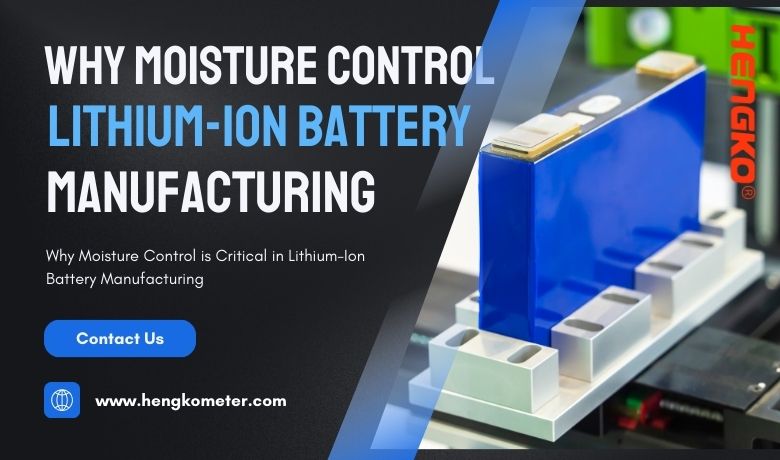Įvadas
Lithium-ion batteries are foundational to modern technology, powering everything from smartphones to electric vehicles. Their efficient energy storage has led to surging demand amid a global shift toward sustainable energy solutions. The quality of these batteries is especially crucial for electric vehicles, where performance and safety are paramount.
Manufacturing high-quality lithium-ion batteries requires meticulous precision. Even slight deviations in materials, assembly, or environmental conditions can significantly affect performance and lifespan. A critical yet often overlooked factor is humidity control. Excess moisture can degrade battery components and chemistry, leading to reduced capacity, increased internal resistance, and potential safety hazards. Therefore, stringent humidity management is essential in the battery production process.
The Impact of Moisture in Lithium-Ion Battery Manufacturing
Moisture control is critical in the production of lithium-ion batteries due to the highly reactive nature of their components. Even trace amounts of water can have detrimental effects on battery performance, safety, and longevity.
Degradation of Battery Components
Excess moisture can lead to the degradation of vital battery components. For example, lithium salts in the electrolyte are susceptible to hydrolysis when exposed to water, resulting in the formation of hydrofluoric acid. This corrosive acid can damage the electrodes and other internal parts, compromising the battery’s structural integrity and functionality.
Reduction in Battery Life and Performance
Unwanted chemical reactions induced by moisture can significantly reduce a battery’s lifespan and efficiency. Moisture can degrade the electrolyte and active materials, increasing internal resistance and decreasing capacity. These changes lead to diminished performance, shorter run times, and a reduced number of charge-discharge cycles.
Increased Risk of Short Circuits or Failures
The presence of moisture increases the likelihood of short circuits and battery failures. Water can facilitate the growth of metallic lithium dendrites, which may pierce the separator between the electrodes. This breach can cause internal short circuits, leading to overheating, fires, or even explosions, posing serious safety risks.
Contamination During Assembly
Moisture can introduce contaminants during the assembly of battery cells. Water molecules can adsorb onto electrode surfaces and separators, affecting the uniformity and purity of the materials. This contamination can lead to inconsistencies in cell performance and yield rates, making quality control more challenging and increasing manufacturing costs.
Critical Stages Where Humidity Control is Essential
Maintaining strict humidity control is vital during several key stages of lithium-ion battery manufacturing. Moisture can adversely affect materials and processes, leading to compromised battery performance and safety risks.
Electrode Coating
In the electrode coating stage, active material slurries are applied to current collectors to form the battery’s electrodes. Moisture can affect the slurry’s viscosity and drying rate, leading to uneven coating thickness and poor adhesion to the substrate. High humidity can cause the binder materials to absorb water, resulting in inconsistent coatings that degrade battery efficiency and lifespan.
Electrolyte Filling
During electrolyte filling, liquid electrolytes are introduced into the assembled cells. These electrolytes are highly sensitive to moisture; exposure can lead to hydrolysis of lithium salts, producing unwanted byproducts like hydrofluoric acid. This acid is corrosive and can damage internal cell components, increasing internal resistance and reducing overall battery performance and longevity.
Sealing and Packaging
Sealing and packaging must be conducted in dry environments to prevent trapping moisture inside the cells. Residual moisture can initiate undesirable chemical reactions over time, leading to gas generation, swelling, or leakage. Ensuring a low-humidity environment during sealing helps maintain the integrity of the battery and prevents long-term degradation.
Storage of Battery Materials
Excess humidity during the storage of battery materials can lead to their degradation before they are even used. Moisture can oxidize electrode materials or decompose electrolytes, affecting their chemical properties and performance. Proper storage conditions with controlled humidity levels are essential to preserve material quality and ensure consistent manufacturing outcomes.
Key Humidity Control Solutions for Lithium-Ion Battery Manufacturing
Effective humidity control is crucial in lithium-ion battery manufacturing to prevent moisture-related issues that can compromise battery performance and safety. Implementing real-time humidity measurement using advanced sensors and transmitters ensures that environmental conditions remain within optimal ranges throughout the production process.
Importance of Real-Time Humidity Measurement
Real-time monitoring allows manufacturers to immediately detect and address any deviations in humidity levels. By continuously measuring the relative humidity, producers can proactively manage moisture levels, preventing the degradation of sensitive components and minimizing the risk of contamination. This immediate feedback is essential for maintaining the integrity of materials and ensuring consistent product quality.
Humidity Sensors
High-precision humidity sensors are essential tools for accurately monitoring the relative humidity in manufacturing environments. These sensors are designed to detect even minor fluctuations in moisture levels, providing accurate data that is critical for sensitive production stages like electrode coating and electrolyte filling. By deploying sensors in key areas, manufacturers can maintain tight control over environmental conditions, reducing the likelihood of moisture-induced defects.
Humidity Transmitters
Humidity transmitters work in tandem with sensors to provide continuous, real-time data feedback. They convert the sensor readings into signals that can be integrated with control systems, enabling automatic adjustments to environmental controls such as dehumidifiers and HVAC systems. This seamless integration ensures that humidity levels remain within specified parameters, enhancing the efficiency of the production process and improving overall product quality.
Integration into the Production Process
Integrating humidity control systems into the manufacturing workflow involves placing sensors and transmitters strategically throughout the production facility. These devices feed real-time data into centralized control systems, allowing for immediate adjustments to environmental conditions. By proactively managing moisture levels at every stage—from material storage to final assembly—manufacturers can prevent moisture-related issues before they arise. This integration not only safeguards the quality of the lithium-ion batteries but also enhances operational efficiency by reducing downtime and waste associated with humidity-induced defects.
Benefits of Effective Moisture Management
Implementing strict moisture control in lithium-ion battery manufacturing offers numerous advantages that enhance both product quality and operational efficiency.
Improved Battery Performance
Effective moisture management ensures that the battery components remain free from moisture-induced degradation. By preventing unwanted chemical reactions—such as the hydrolysis of lithium salts—the batteries can achieve higher energy density and longer cycle life. This results in superior performance, allowing devices and vehicles powered by these batteries to operate more efficiently and for extended periods.
Increased Manufacturing Yield
Controlling humidity reduces the incidence of defects and waste during production. Moisture-related issues can lead to a higher rate of rejected cells, impacting overall yield. By maintaining optimal humidity levels, manufacturers can increase the number of functional battery cells produced, maximizing resource utilization and improving throughput.
Enhanced Safety
Moisture can cause internal short circuits and other failures due to the formation of dendrites or gas generation from unwanted chemical reactions. Effective moisture management minimizes these risks by preventing moisture-induced defects. This leads to safer batteries with a lower likelihood of overheating, swelling, or catching fire, thereby protecting end-users and enhancing the manufacturer’s reputation.
Cost Efficiency
By reducing defects and minimizing the need for rework caused by humidity exposure, manufacturers can significantly cut costs associated with waste and additional labor. Effective moisture management streamlines the production process, reduces material waste, and decreases downtime, leading to overall cost savings. This efficiency not only benefits the manufacturer’s bottom line but also contributes to more competitive pricing and better market positioning.
Išvada
Overall, Effective moisture control is paramount in lithium-ion battery manufacturing.
By preventing moisture-induced degradation of components, manufacturers can enhance battery performance, safety, and lifespan.
Accurate moisture measurement and control systems play a vital role in this process, offering real-time data that enables proactive management of humidity levels. Implementing these systems not only improves product quality but also boosts operational efficiency by reducing waste and minimizing defects.
For more information on advanced humidity control solutions, please contact HENGKO at sales@hengkometer.com.






